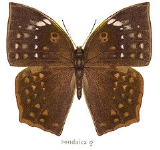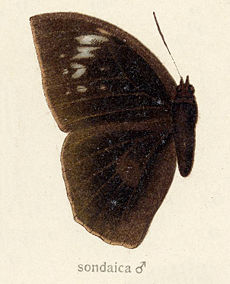
Discophora sondaica
Encyclopedia
The Common Duffer, Discophora sondaica is a species of nymphalid
butterfly
found in Southeast Asia
.
Upperside of male dark brown. Fore wing with transverse discal, postdiscal and subterminal series of bluish spots, the latter two series closely approximate. Hind wing uniform except for the prominence of the discal secondary sex-mark, and faint indications of a subterminal series of pale spots. Underside a dull ochraceous brown, the basal half of the wing is darker, denned outwardly by a still darker but obscure transverse band ending in a lilacine diffuse small patch at the torn us of the hind wing; both fore and hind wing irrorated somewhat sparsely with short transverse brown striae and obscurely tinted with lilac; two ill-defined ocelli on the hind wing as in Discophora celinde. Antennae ochraceous; head, thorax and abdomen brown, paler beneath.
Female has an upperside of purplish brown. Fore wing with three transverse series of white spots, the inner or discal series continued to the costa by two large elongate obliquely-placed white spots. Hind wing also with three transverse rows of somewhat obscure spots, but ochraceous in colour. Underside similar to that in the male, but paler.

Nymphalidae
The Nymphalidae is a family of about 5,000 species of butterflies which are distributed throughout most of the world. These are usually medium sized to large butterflies. Most species have a reduced pair of forelegs and many hold their colourful wings flat when resting. They are also called...
butterfly
Butterfly
A butterfly is a mainly day-flying insect of the order Lepidoptera, which includes the butterflies and moths. Like other holometabolous insects, the butterfly's life cycle consists of four parts: egg, larva, pupa and adult. Most species are diurnal. Butterflies have large, often brightly coloured...
found in Southeast Asia
Southeast Asia
Southeast Asia, South-East Asia, South East Asia or Southeastern Asia is a subregion of Asia, consisting of the countries that are geographically south of China, east of India, west of New Guinea and north of Australia. The region lies on the intersection of geological plates, with heavy seismic...
.
Description
- See glossaryGlossary of Lepidopteran termsThis glossary describes the terms used in the formal descriptions of insect species, jargon used mostly by professionals or entomologist....
for terms used
Upperside of male dark brown. Fore wing with transverse discal, postdiscal and subterminal series of bluish spots, the latter two series closely approximate. Hind wing uniform except for the prominence of the discal secondary sex-mark, and faint indications of a subterminal series of pale spots. Underside a dull ochraceous brown, the basal half of the wing is darker, denned outwardly by a still darker but obscure transverse band ending in a lilacine diffuse small patch at the torn us of the hind wing; both fore and hind wing irrorated somewhat sparsely with short transverse brown striae and obscurely tinted with lilac; two ill-defined ocelli on the hind wing as in Discophora celinde. Antennae ochraceous; head, thorax and abdomen brown, paler beneath.
Female has an upperside of purplish brown. Fore wing with three transverse series of white spots, the inner or discal series continued to the costa by two large elongate obliquely-placed white spots. Hind wing also with three transverse rows of somewhat obscure spots, but ochraceous in colour. Underside similar to that in the male, but paler.


